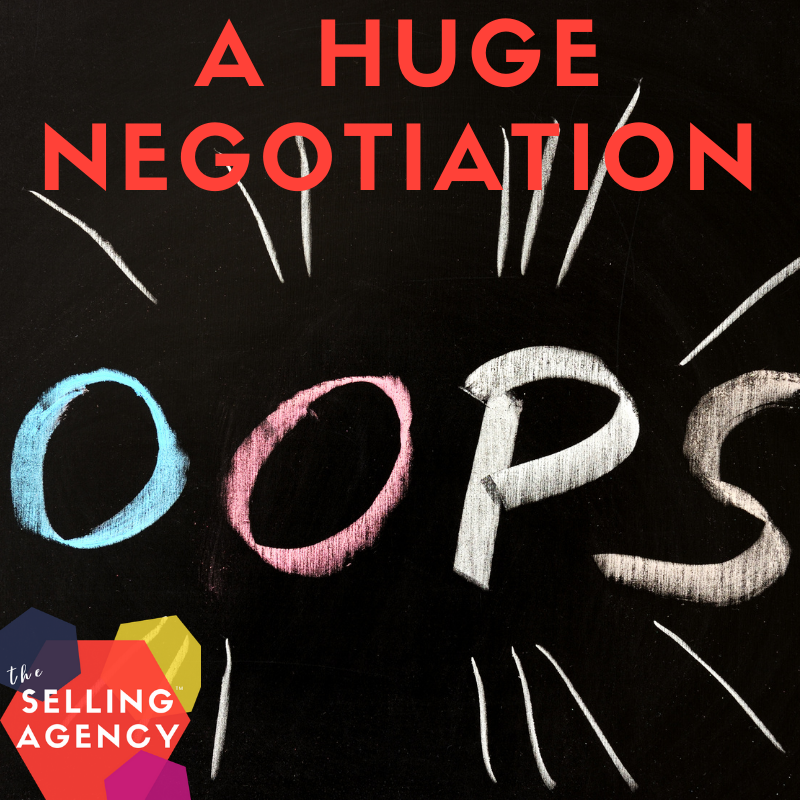I surveyed a sales team recently – prior to a Skills Building session on Pushback, Objections, and Negotiation – and asked them some of the most common obstacles they face in business development.
Their answers didn’t surprise me, but one of the things about their answers that I pointed out really made them think – even left a few of them speechless and really pissed at themselves for how often they have made this one particularly expensive error.
One of the most common expressions of objections … isn’t really an objection or asking for a discount. It’s a probe. A scout. Buyers are chumming the waters, seeing if you’ll bite – sometimes, they’re not even consciously aware of what they’re doing … it’s just that sneaky!
One of the most damning things sellers do is start negotiating BEFORE the client even asks for a discount or negotiation point.
Here’s what usually happens:
We reach a point in the buying process where we give the customer a proposal or price and terms.
They say, “Hmmm, your competitors are lower …”
And then we, eager and unfailingly predictably jump in with, “Well, how about XYZ price?”
We just started the negotiation process for them and in many instances, jumped straight to discount and bargaining instead of pushing back on our value for our offer.
The buyer didn’t ask for a lower price. He simply implied that the price didn’t match the competition and we, as sellers, infer that he is asking for a discount.
This happens with a lot of statements from buyers (these are many of the examples received from that same seller’s survey):
- Your competitor’s price is lower …
- Your competition is not raising fees …
- Our existing terms include free delivery …
- Is this the lowest you can go?
Sound familiar?
NONE of these examples are express asks for a discount, or lower fees.
These are not direct asks. They’re indirect, which should be a BIG RED FLAG for you:
Your buyers probably aren’t comfortable asking for a discount or negotiating. They cast the line – looking to see if you bite.
If your buyer feels the same discomfort about negotiating as you do, why are you making it easier for them?
They don’t even have to ask, we just offered to lower our prices to make THEM more comfortable and relieve ourselves of the fear and neurological stress of conflict.
If they dance around it with an indirect implication, they’re just as uncomfortable about asking as you are about responding – which means they want to exit negotiation quickly.
Most of us don’t fear the other person across from us at the table during negotiation. We loath the feeling of fear – the physiological response we have to our perception of objections and negotiation as “conflict” instead of its real purpose as an alignment mechanism.
A firm resolve and preparation will withstand their implication and you can retain more margin and revenue.
Don’t DO THE BUYER’S WORK FOR THEM.
Instead, when your buyer implies that they would prefer different terms or fees, try a deflective measure where you acknowledge their statement – as a statement, and NOT respond to it as a question. You can move the conversation to value if they continue … or they’ll simply sign and execute if they truly don’t have any objections and were simply hoping you’d offer up a more attractive deal. If they want to negotiate, make them initiate the process, NOT YOU.
Here’s how the exchange might go down:
Buyer: Your competition’s rates are lower.
You: I understand. [SILENCE after that statement]
Buyer: So … [awkward pause] this is your best price?
You: It is. Is there someplace in here that doesn’t reflect the value you’re expecting?
Buyer: Well, no … I was hoping for a discount.
[NOTE*** The buyer still has NOT directly asked for a discount.]
You: Sorry, a discount?
Buyer: Ok. Let’s do it.
That’s a perfectly scripted example. Situations are NEVER this perfect. That’s why preparation and practice are key for handling pushback, objections, and negotiation.
As Mike Tyson says, “Everyone has a plan … until they get punched in the mouth.”
What are you going to do when your buyer throws up an objection, wants a discount, or serves up something completely unexpected (right hook)?
- First, don’t dig yourself a hole by starting to negotiate or discount with them even having to ask for it. Think of how much revenue you could get back if you didn’t start the negotiation process before your customer ever asked?!?
- Second, be prepared and practiced so you don’t operate and rush from fear to make the uncomfortable feelings end. Learn to think rationally instead of emotionally during negotiation.
You’ll come to more solid win-win and collaborative solutions when you’re not jumping the gun on negotiation to avoid feelings of conflict.
Until next time, stop hoping and start SELLING!
-sks
PS – We’ve developed an extremely powerful Skills Session to teach sellers how to slow down and push back to pushback and objections in a methodical, deliberate way. If you’re not preparing and practicing for these challenges, contact us to show you how you can keep more margin and revenue in your sales deals.











